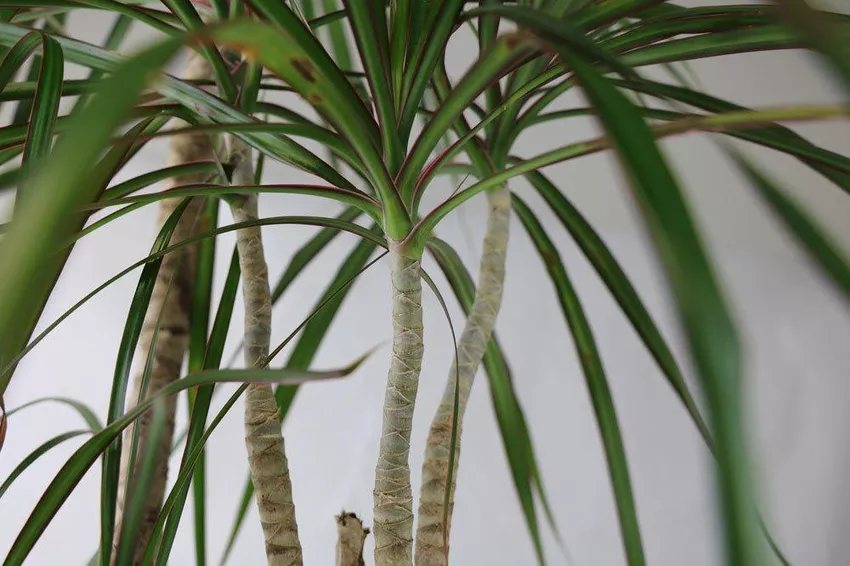
The dragon tree (botanically Dracaena) is a genus of plants that looks very similar to the yucca palm. Numerous species have become popular houseplants. The Dracaena species are valued for their exotic, palm-like appearance. Dragon trees are very easy-care plants. Nevertheless, a cut is sometimes advisable.
cut dragon tree
reasons for a cut
You can cut a dragon tree for different reasons. The following reasons are given most frequently:
Stimulating more lush branching
Especially when a dragon tree grows in places with less light, shoots that are long and bare often appear. Small tufts of leaves form at the tips. In order to stimulate branching, a pruning should be carried out in addition to a change of location. Several new shoots usually form on the cut ends, so that the dracaena grows more branched.
regulation of growth height
Dragon trees grow quickly, so that the small indoor plant can grow into a stately plant over the years. The growth in height can be regulated - at least in the medium term - by radically shortening the Dracaena. After a cut, your plant usually grows bushier and less straight in height.
Correction of the direction of growth
Dracaena love the light and accordingly grow towards the light source. If your plant has developed a clear overweight on one side, nothing usually helps more than shortening it below its sloping growth. After a change of location, the plant should then grow branched upwards again.
Propagation of the dragon tree
You can also use the cut to propagate. To do this, you can free the cut upper end from the foliage and, if necessary, divide the trunk into several pieces. You can then place them in a glass of water. New roots form after a few weeks.
 Dragon tree, dracaena fragrans
Dragon tree, dracaena fragrans
Optimum time
Spring is the best time for pruning because the plant has the sunnier months ahead of it in order to regrow sufficiently. In addition, if possible, you should only cut the dragon tree every two years so that the plant can regenerate sufficiently.
tools and materials
To cut your dragon tree, you need tools to shorten the plant and to professionally seal the interfaces.
- Optional: sharp secateurs, a small handsaw and/or a sturdy knife
- Means for wound closure
- alcohol for disinfection
- Wooden stick, rubber brush, rubber gloves and/or brush
Shorten Dracaena: instructions
Decide on the cutting tool that you are most comfortable with. It is important that the devices sharp are. To avoid bringing germs into the wound of your plant, you should disinfect your cutting tool with alcohol before use.
You can shorten the dragon tree at any height, as the plants are able to sprout again on old leaf bases. If you are interested in propagating the Dracaena, you should at least see the trunk ten Cut an inch below the head. You should shorten the leaves to about an inch. If you have decided to prune to correct the growth of your dragon tree, you should at least do it two Cut off centimeters below the treetop.
Regardless of the reason you are trimming your dracaena, you should always take care whenever possible just cut so that the cut surface is as small as possible. In addition, the interface should be as smooth as possible and by no means frayed.
 Dracaena marginata, Marginated Dragon Tree
Dracaena marginata, Marginated Dragon Tree
Seal Dragon Tree
Reasons for sealing the interfaces
Although some horticulturists and hobbyists object to the sealing of interfaces, there are a number of reasons for sealing the interfaces of dragon trees. On the one hand, proper sealing keeps the interface from drying out. On the other hand, no bacteria or other germs can penetrate into the interior of the plant in this way. Fungal spores, in particular, often take advantage of the fine injuries and penetrate the trunk or branches via the interfaces.
suitable material
Anyone who researches the Internet will come across numerous materials that are used to close the wounds. In forums, for example, one reads that coal dust or ash is suitable. Sulfur powder is also advised. In addition, many hobby gardeners recommend ordinary candle wax. There are positive testimonials for all the substances mentioned.
If you want to make sure that you treat the wounds on your dragon tree professionally, it is advisable to use waxes or pastes that are available in specialist shops for this purpose. Here, too, the producers rely on different raw materials, usually based on natural tree resin and/or waxes. Some manufacturers add fungicides to the products, which should also prevent fungal infestation. Breathable products are also on the market.
Proper sealing: instructions
The sealing of the cut surfaces succeeds in a few steps:
- Check for a clean, straight cut
- If necessary, repair the cut and create a smooth surface
- clean interface
- Wet the surface with water
- Apply wound closure agent using a wooden stick, rubber brush, brush or rubber gloves
- Smooth out wound closure agent
- Remove excess wound closure agent
If you have decided to buy a professional wound closure product, you should definitely follow the manufacturer's instructions. Some products already include a brush for application.
 Dragon tree, Dracaena marginata
Dragon tree, Dracaena marginata
Care after cutting and sealing
Even if you have properly sealed the interfaces of your dragon tree, you should also dry out prevent your plant. To do this, place the tree in a shady place for a short time. Also give the dracaena enough water, making sure that there is no waterlogging. The plant is prone to rotting roots if overwatered. Now is also the right time for fertilizing so that your dragon tree has enough energy for new growth.